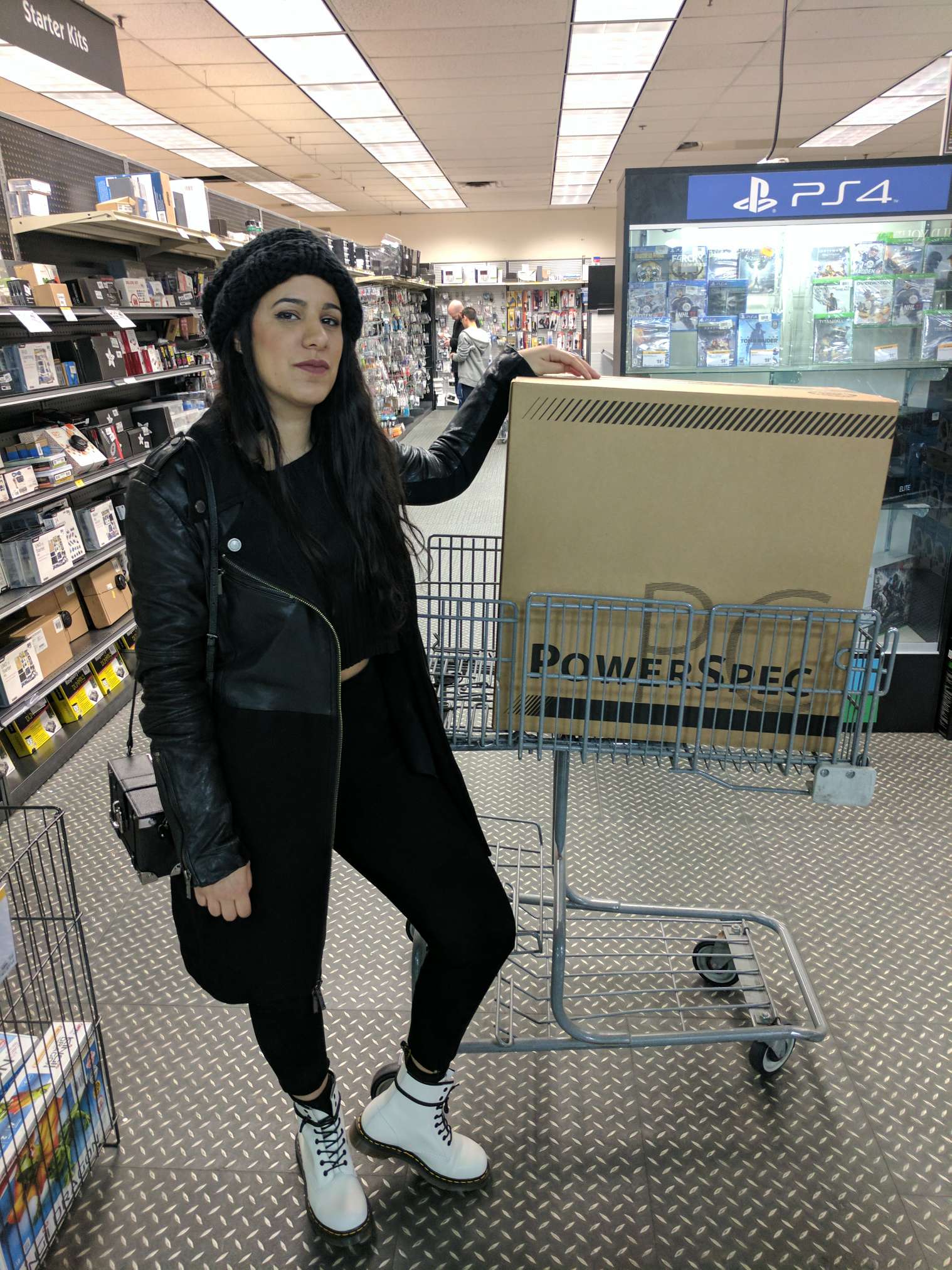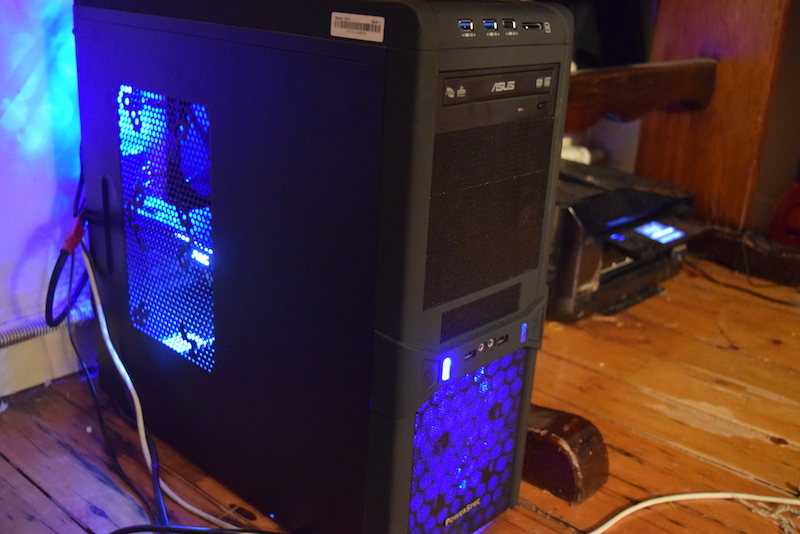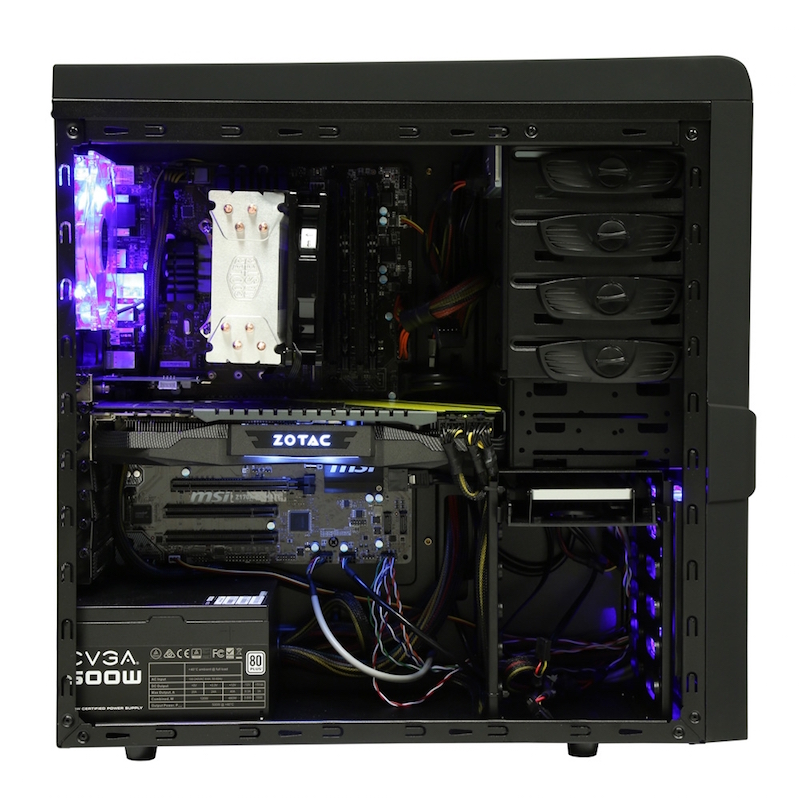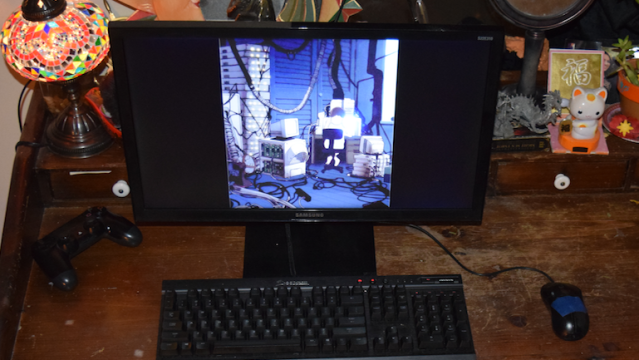My desk, complete with my new gaming PC and several toys.
Nothing tests your resolve to identify a certain way like a big, bank-breaking purchase. In December, after five years of back-and-forth, I took the dive and bought a gaming PC. Until I was standing in the Micro Center checkout aisle with a big, stately “PowerSpec” box in my cart, I kicked and screamed the whole way there. “Buying in” is a scary thing, especially when your lifestyle is still possible, but significantly compromised, without doing so.
Prior to pulling out of the Micro Center parking lot, I played Overwatch or Final Fantasy 14 every day on a powerful laptop that needed some deft jerry-rigging to run new games and, for most other things, loaded up my Xbox One. I didn’t want to drop a month’s rent on hardware. And I didn’t want one of those glowing, green gaming PCs equipped with fangs and pincers. For me, there was also the damningly impossible question of “How much PC gaming is enough to justify a gaming PC?” In the end, it was a simple calculation: an unequipped laptop vs. the royal treatment, minus $US1,000 ($1,306).
Getting here took five years, in part, because of a conversation I had every year with a Best Buy employee. It goes like this: I’m wandering around their PC section, checking out their wares or shopping for a new laptop, and I’d encounter some Alien vs. Predator-style gaming rig, with toothy grating, promising to “push optical limits” or “maximise gaming performance,” the copywriting equivalent of steroids. Always, at that moment, a salesperson would initiate this conversation:
“Hi, can I help you?”
“I’m just checking out some computers,” I’d explain.
“Ah, ok. What will you do on the computer?” they ask.
“Well, I write and report, so processing speed is important. I stream television. I also play video games, often online.”
“Oh, so do you want a gaming PC?” they reply. “It sounds like you need a gaming PC. What kind of graphics are you looking for? How much memory? Solid state or-.”
Here, I always shortcircuited. It seems like a simple enough computation — play video games, purchase gaming PC. It’s the last thing I mention, and yet, it’s the most important factor determining which tool I will choose to go about my increasingly online life. It’s not just a matter of “next-gen tech” and “powerful gameplay.” It feels, in a way, like this bored, run-of-the-mill Best Buy employee stands before the gate that leads to some gilded tower of PC gamers. It felt like I wasn’t serious unless I was serious about framerate. I wasn’t a player until my walls reflected the soft glow of a blue LED fan. Buying a gaming PC is just as much an investment in who you are as it is in how you’re gaming.

Me, with my new friend.
But after being hired by Kotaku, how I related to a gaming PC started to change. What seemed like an identity calculation that only transpired in the aisles of Best Buy became part of how I do my job. It’s a sort of insurance for running future games with less difficulty, for being able to get more out of games I already play by having beefier hardware.
That’s only half the truth, though. I bought a gaming PC, in part, because I like winning in Overwatch. Since it’s team-based, your teammates know if you’re lagging on your rush out of the spawn point. Also, Overwatch isn’t one of those games where it’s fine for your computer to overheat in the middle of a competitive match. That’s the beast I was wrestling.
To play Overwatch on my HP Envy laptop, with its Nvidia GeForce 930M graphics card and its i7-6500U microprocessor, I had to construct a somewhat elaborate superstructure that involved two to three fans and, occasionally, a dictionary. My Envy is not a bad laptop by any means, but four or five matches in, it would get hot and angry and hiss. Most of the time, it would shut down without warning — just a small sigh. Its Overwatch aversion was a little confusing, since it ran all my other PC games just fine — Final Fantasy XIV, most importantly.
To appease it, I purchased a cooling pad with a fan inside and a mini fan that sat on my desk and blew into its fan. Sometimes, I put a dictionary under it to get just the right angle or leaned it against some books just so. When none of that worked, I dragged my 1.22m floor fan next to my desk and directed its wind into the desk fan which, in turn, blew into the laptop fan.
After a while, my laptop just stopped having it. My bosses eyed me as I made my bi-weekly pilgrimage to Staples, insisting it was time. Staples’ technicians warned me that it was only going to get worse unless I got a rig more suitable for gaming.

PowerSpec friend.
My first impulse was to build one. I would go on PCpartpicker.com, and, with requisite research, piece together a custom build. It wasn’t particularly intimidating — as Kotaku managing editor Riley MacLeod said, “Building a gaming PC is just like grown-up Legos.” I reasoned that by building my own PC, I would familiarise myself with its internal organs and, if something broke, I could identify the problem myself.
It would be an exciting challenge and teach me a new, useful knowledge set. That was my plan, and if you ask my friends, I wouldn’t shut up about it.
But on December 26th, while I was home over the holidays, I took my parents’ car to a Virginia Micro Center to purchase a more powerful cooling fan for my laptop, hoping it would hold me over until I mustered the courage to order parts. Micro Center is a vestige of early computing, one of the few brick and mortar computer stores where, in my experience, salespeople always seem knowledgeable and never pushy. When I entered, I saw the sign hanging over their desktop section and made a beeline there, forgetting my original task. All of the employees seemed busy, so I could wander around without anybody quizzing me on my gaming habits or dream specs.
As I looked over the glowing green towers and jagged, toothy rigs, a few larger but more innocuous desktops caught my eye. There was a table with about five two-foot-tall towers, each with at least two ventilation grates and top-notch graphics cards, all under about $US1,100 ($1,437) — not an insignificant sum, by any means.
One in particular, a PowerSpec G313 custom build, had many of the features I wanted out of my own build. I wanted a 1070 graphics card, since a 1080 was definitely out of my price range. It had 16GB of RAM and an i5-6600K unlocked processor. It could handle VR. It had a 480GB solid state boot drive. It was $US999 ($1,305).
A customer, not a salesperson, approached me. “Hey, I don’t mean to bother you,” he began, “but I have that PC. It’s amazing.” I immediately shot him a dozen questions and, enthusiastically, he explained that, yes, it handles Blizzard games with maxed-out settings and, absolutely, he does not regret buying a pre-built gaming PC. A salesperson joined the conversation, noting that the graphics card alone would cost $US500 ($653), only $US300 ($392) less than my DIY price limit.
Purchasing each of its parts separately, the PC would have cost about $US1,300 ($1,698). Considering the specs, it was a steal. Also, it has space for another graphics card, so if in five years my 1070 wasn’t doing the trick, I could just add another.

From Micro Center
Perhaps it was impulsive, but I bought it. I took it back to New York and hooked up a discounted, but new, 21″ Samsung monitor. I crammed the enormous 18 by 18cm tower under my desk. The keyboard was a hand-me-down from my dad, who accidentally purchased a Corsair mechanical keyboard for himself off the internet and was deterred by the clanking. My mouse, honestly, I could care less about. I found it in a box in my room.
After installing Windows and running a LAN cable through the apartment, the first thing I did was download Battlenet and play Overwatch. As a Roadhog main, my hook percentage is at least five per cent higher now that the game runs better. I’ve picked up some offensive heroes who require cutting reflexes now that I have a rig that can handle it. And, galvanised by this sudden boost in performance, I solo-queue in competitive mode nearly every night now.
I’ll add that, in the past, I was afraid to speak up in voice chat because I am a woman. Now, I am unafraid. I have a new confidence stemming from boosted gameplay and, frankly, “buying in.”
Perhaps it’s all a mindgame. And, undeniably, I was a victim of some very good marketing from the PC gaming industry. I think back before I felt comfortable making this sort of big, meaningful purchase and wonder what was stopping me aside from price — impromptu quizzes at Best Buy, the super-fanatical culture of PC gaming? There are mental barriers-to-entry and traversing them are scary, even aside of money, and especially when they’re reinforced by others who already made the financial leap and constantly seek to justify it. But it’s a sad truth — “buying in” is a way of feeling at home.

Comments
25 responses to “How I Convinced Myself To Buy My First Gaming PC”
Great read.
The worst of the worst out there in PC-land (especially when speaking in AUD dollar terms) would have you believe you don’t need anything but a PC and then you should be thankful that a device can do everything they say it can as well.
I would never ever recommend those pre-built monstrosities you see in Harvey Norman that are advertised as ‘gaming PCs’ and I don’t know why any other enthusiast would.
That said, a similar investigation or experience that someone’s had with such a purchase, locally, would be very interesting to read as well.
I was lucky, I had a budget to work with and I researched the parts I wanted. I then built my gaming PC and overall the experience was relatively painless.
Except if you count the motherboard cutting into my fingers as I installed it in the case. It’s literally got my DNA all over it now, this baby of mine.
Harvey Norman? Good god no. The salespeople there are just that – salespeople. They get a commission based on what they sell you, so they are going to direct you to the rig at the tippy-top of your price range, regardless of whether it’s suitable or not.
If you take a dedicated PC retailer like PC Case Gear you can get a much better deal. Take one of their 1060 systems – pretty well balanced with no obvious bottlenecks and some nice hardware. If you add up the price for all the components you would pay $1514, and they’re charging $1599. For a lot of people, paying $85 to have a system built and tested is a small price to pay, particularly if they aren’t confident building their own system.
That being said, the ‘adult lego’ comparison is pretty bang on. I had a great time researching and building my current PC, even though I’d never even opened the case on a desktop before, with the added benefit that I can now troubleshoot most hardware problems myself instead of turning straight to friends or technicians. It’s not for everyone though, so I can definitely see the appeal of prebuilts for some.
If you’re going to go pre-built locally, then PCCG or PLE are the way to go. PCCG are generally cheaper, but their PCs are for the most part pre-built with set parts. With PLE you pay a bit more but are completely free to pick the parts you want.
I had my first desktop built by PLE and the service was exceptional, quick, and the quality was good.
I’ve still got that PC, but since then I’ve changed a bunch of components myself (swapping to an AIO cooler, replaced the GPU etc. Just baby things).
My power supply is bigger than that “tower”.
Bad imperial/metric conversion strikes again?
I’m going to make a guess that
1. US article
2. Crappy auto conversion failed and that it’s 18″ and not cm
I can definitely recommend building. You can custom pick the parts you want and decide where you want to skimp to save money, and with online guides it’s easy-ish to figure out how it all goes together.
Then you can fill it with LED lights so it glows in the dark like a mofo.
Pre-built are a lot better now than they where 10 or 20 years ago. At least – in the main – they tend to use regular components and not weird custom configs and components designed to prevent upgrading.
Remember the preponderance of computer “stores” offering their own pre-built PCs targeted at people with little to no PC knowledge… An ex-GF’s parents had one from a seller here in Perth that used to advertise prominently in papers and TV, the PCs where pieces of shit … Worse though, when they where having problems with it and I tried to enter the bios to check settings, it was admin locked so you had to take it back to the store to acces it.
I was always a pro-desktop advocate. However, I remember during the time of ps3, I managed to convince myself I didn’t need anything but a very powerful laptop. Well i was generally working overseas that forced me to resort to mobile means. I was also under the impression that apart from World of Warcraft I didn’t need a more powerful rig as most good games were on consoles. It was only a few years ago I returned to desktop PC gaming, and I suddenly realized how much I had been missing out on.
To think I almost managed to convince myself a laptop was fine. I almost lost touch with the true reality of it all. Hell, some of my friends have fallen to the charms of the laptop even though they use to be desktop aficionados like me in our younger years. But they are too far gone to come back. They firmly believe apart from the laptop, the PS4 console was all they need.
Coming back to PC gaming has opened my eyes again. I am now buying a lot of console released games on PC instead. My friends come over and look at it and usually say “looks just like console”. I simply shake my head. “No… no it doesn’t”. But then I guess its like trying to tell someone back in the day that Bluray looked better than dvd. Unless you plonk them down in front of the screen side by side will they realize the true difference. I’ve given up convincing them. At least i know in my own heart that desktop gaming is the real deal, and console or laptops cannot come close to the feel of the power. Even the newer powerhouse laptops will be good at the beginning, but i still suspect long term play on it will cause heat issues. I’m never going back. MWAHAHAHAAHAHA unless i go overseas again and am forced to use a laptop. :S
The flip side of that is that mobile GPUs have significantly closed the gap (provided you’re not too worried about battery life). I have a laptop with a 1070 which comes close to desktop performance, so I have the best of both worlds – particularly since the consoles have slowed down the endless hardware cycle we used to be on, particularly around the early to mid 2000s. I don’t really have any issue with heat – they’re designed for this sort of thing.
I too went off onto a console tangent and came back to PC gaming, but one thing I’ve noticed is that couch gaming is still awful by comparison. Even with a Steam Controller or using Steam Link, you’re still stuck trying to compromise in a lot of games, or you end up resorting to a mouse and keyboard which is awful for a couch (may as well sit at a desk).
External GPU housing also makes the difference negligible – use the more basic inbuilt GPU when you’re on the road, and still have the grunt of a desktop GPU when you’re at home.
I was a PC gamer/elitist for many years but these days my gaming rig sits in a pile on the floor for the vast majority of the time. I take it out to LAN’s but don’t even bother setting it up again when I get home now as my MBP is nicer to use for general stuff/work and my PS4 is easier for casual gaming. I think the best gaming device is the one that you’ll use the most, and for a lot of people that will be a console, especially these days when consoles do offer a really good gaming experience.
Discussions like this fail to factor in a truth we all take for granted, constantly: The software choice available diminishes the more you travel down the exclusivity route.
You’re not going to say to someone ‘spend all this dosh’ so you can then only play something like Cyberpunk 2077 and Cyberpunk 2077 only.
No, the great majority of the higher-end content you’re likely to play is already platform-agnostic. It’s designed to be ‘held back’ by quite a bit, so it can run on various consoles and platforms.
Tablets for one.
Rather, you’re trying to help someone understand why they should treat their decisions regarding a gaming device with the same mind-set they’d use when weighing up the sort of car they are about to buy next. That’s not easy. Doubly so when you’re biased anyway with your own personal gaming tastes.
I built a PC to play Witcher 3 and Arkham Knight, I haven’t touched either because I’m in love with Overwatch.
The same way one can say I bought a 4WD to go camping but in reality it’s a people mover and shopping trolley for my four kid family. One day, one day.
Very interesting read !
*bites hole in lip*
So to write for Kotaku US, you don’t need to actually be a gamer with something better than a toaster for a PC? I hope Kotaku AU actually has standards for their writers… oh wait.
Why on earth would your tech have any bearing on your ability to write? Even if it did isn’t low end gaming something that readers would be interested in?
The arrogance of this is completely unnecessary. Gaming on a console is perfectly fine (as to your original allegation) and not having a $2000-plus rig hasn’t impacted her ability to write, report, or craft a great story. It might also help if you go back and look at what she’s actually written about before putting the boot in.
Man I wish gaming on a console was perfectly fine. Everything is so much simpler. The achievements are wonderful and every game has them, unlike Steam. The graphics really aren’t that bad anymore, at least on the Xbox One X. But I just can’t justify paying for online when I can do it for free.
I’m currently having a midlife crisis in my 20s and so I fear that knowing my Xbox Live Gold is going to run out every 12 months will make time feel faster to me.
Ok now to eat some glass wow that was really random I’m so tired it’s 11:34 PM goodnight. also no disrespect to whoever I’m writing to at all, i don’t even know how i got here sorry
It’s cool! You can always hit me up directly too (Twitter usually) if you want to chat.
You do need to be careful when buying pre-packaged pc’s. I learned my lesson the hard way, after many life cycles of being behind everyone else (486 in the mid 90’s, P2 late 90’s, P4 mid 2000’s). When it was time to update in the usual 4-5 year cycle I decided that I wanted to be somewhat more current than previously. Opted to buy a computer shops pre-packaged pc, it had some grunt………. a year and a half into it the power supply blew up. I had since discovered that they did well with various internal parts (GTX 460, top quality ram, decent brand hard drive)…….. but they undid all that good work with a no name brand power supply. My own fault for not investigating what parts they had that made the system. My current pc was custom built by Scorptec (I basically took one of their pre built systems and chopped and changed a few parts more to my liking). Five years later and it’s still ahead of the curve in regards of minimum/recommended system specs for games. I’m at the stage where I should be updating to a new system HOWEVER there is little point in doing so, over this 5 year period there has not been a huge leap technology wise (sure video cards are more powerful these days.. I started with a 560 Ti, upgraded to a 780Ti which still gets the job done). But cpu chips, ram have not had a huge technology leap. Whereas back in my 5 year cycle system purchases, I’d see the difference easily (whether it was 500mhz speed difference or jumping up 1.5-2.0 ghz in processing speed). I’ve got to try and hold out to when cpu’s are at 5.0ghz or something.
Fantastic read, took me back to the bad old days when I decided to build a computer without any prior knowledge. What a nightmare…
So am curious as an MMO/MOBA gamer why you went as high as a gtx 1070. Is that not overkill for the main games you play? I find this particular audience intriguing. Do most just play these types of games and have no interest in high graphical games. Looking at Steam Survey data it suggests the huge majority are on low level hardware mainly because most are playing MMO/MOBA games which have very low min requirements to play. Why would they have a need to upgrade?
I’ve been thinking about getting a gaming PC for a while now, but I don’t have the money to get one. Would buying a prebuilt PC be more optimal for my needs? or should I build one?
Had an Xbox One, then One S, then One X. Sold the One X to help pay for a gaming PC. Sold the gaming PC because I hate Steam.
Got another One X. Got my first ever PlayStation this month, the PS4 Pro.
Now I’ve sold the PS4 Pro and am selling the One X as well as a small action figure collection to help pay for a super high-end gaming PC.
I refuse to pay for Xbox Live Gold and PlayStation Plus just so I can play online when I can play online for free on PC.
But I’ll probably end up selling the $3300 PC and get an Xbox One X again. Not PS4 though, not after I learned that PS5 won’t play PS4 games and that you have to have PlayStation Plus to save data to the cloud.
Man I hate Steam.
That is all.